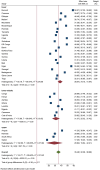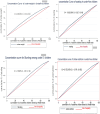Wealth-related inequalities in undernutrition among under-five children in sub-Saharan Africa
- PMID: 40447590
- PMCID: PMC12125319
- DOI: 10.1038/s41598-025-01842-1
Wealth-related inequalities in undernutrition among under-five children in sub-Saharan Africa
Abstract
Undernutrition among under five children is a significant public health concern and a key factor in child mortality in developing nations. Addressing early childhood health disparities requires increased focus, as these issues are likely to persist into adulthood. This study examined wealth based inequalities in under-five undernutrition across 35 sub-Saharan African countries. This study utilized a total of 202,290 weighted samples from Demographic and Health Survey datasets across 35 sub-Saharan African countries. Data cleaning was performed using MS Excel, followed by extraction and analysis with STATA V.17 software. To assess wealth-related inequalities in undernutrition, the concentration index and curve, along with Wagstaff decomposition analysis, were employed. A p value of less than 0.05 was considered statistically significant. The overall pooled prevalence of undernutrition among children under five in sub-Saharan Africa was found to be 35.5% (95% CI 32.08, 38.88%), with a high heterogeneity (I2 = 99.9%). Prevalence rates varied significantly, ranging from 17.25% in Gabon to 58.57% in Burundi. The concentration index for wealth-related inequality in undernutrition indicated a pro-poor distribution, with a value of CI - 0.1719 (95% CI - 0.179, - 0.165) and a standard error of 0.0037 (p value < 0.0001). The decomposition analysis revealed that factors such as media exposure, access to improved water sources, improved toilet facilities, and maternal education were inversely associated with undernutrition. In contrast, living in rural areas and maternal occupation showed a positive association with undernutrition. Wealth related disparities to undernutrition showed a trend that favored poorer populations. Individuals from lower socioeconomic backgrounds were more likely to experience undernutrition compared to those from higher socioeconomic groups. Key factors contributing to wealth-related inequalities in child undernutrition included media exposure, place of residence, and access to sanitation facilities. The persistence of these inequalities highlights a significant social injustice. To effectively reduce these disparities, it is essential to implement integrated interventions during early life that address the multiple challenges faced by disadvantaged children. Therefore, policies should take into account the distribution of childhood undernutrition across all socioeconomic groups.
Keywords: SSA; Under-five children; Undernutrition; Wealth inequality.
© 2025. The Author(s).
Conflict of interest statement
Declarations. Competing interests: The authors declare no competing interests. Ethics approval and consent to participate: Ethical approval and informed consent were not required for this specific study since it was a secondary data analysis of publicly available survey data from the Measure DHS program. We requested DHS Programme data archivists, and permission be granted to download and use the data for this study from www.measuredhs.com . All the procedures were carried out in accordance with the relevant regulations and the Declaration of Helsinki.
Figures
Similar articles
-
Socioeconomic inequality in undernutrition among late female adolescent in sub-Saharan African countries: a decomposition analysis.BMC Public Health. 2025 Apr 25;25(1):1549. doi: 10.1186/s12889-025-22807-z. BMC Public Health. 2025. PMID: 40281575 Free PMC article.
-
Does socioeconomic inequality exist in minimum acceptable diet intake among children aged 6-23 months in sub-Saharan Africa? Evidence from 33 sub-Saharan African countries' demographic and health surveys from 2010 to 2020.BMC Nutr. 2022 Apr 7;8(1):30. doi: 10.1186/s40795-022-00521-y. BMC Nutr. 2022. PMID: 35392989 Free PMC article.
-
Risk Factors of Standalone and Coexisting Forms of Undernutrition Among Children in Sub-Saharan Africa: A Study Using Data from 26 Country-Based Demographic and Health Surveys.Nutrients. 2025 Jan 11;17(2):252. doi: 10.3390/nu17020252. Nutrients. 2025. PMID: 39861383 Free PMC article.
-
Folic acid supplementation and malaria susceptibility and severity among people taking antifolate antimalarial drugs in endemic areas.Cochrane Database Syst Rev. 2022 Feb 1;2(2022):CD014217. doi: 10.1002/14651858.CD014217. Cochrane Database Syst Rev. 2022. PMID: 36321557 Free PMC article.
-
Socio-economic inequalities in malaria prevalence among under-five children in Ghana between 2016 and 2019: a decomposition analysis.Malar J. 2025 May 8;24(1):147. doi: 10.1186/s12936-025-05349-y. Malar J. 2025. PMID: 40340795 Free PMC article. Review.
Cited by
-
Decomposing socioeconomic and educational inequalities in infant mortality in Sub-Saharan Africa: DHS insights linked to countdown to 2030 and agenda 2063.BMC Public Health. 2025 Jul 17;25(1):2488. doi: 10.1186/s12889-025-23683-3. BMC Public Health. 2025. PMID: 40676638 Free PMC article.
References
-
- De Onis, M., Blossner, M., WH Organization. WHO Global Database on Child Growth and Malnutrition (World Health Organization, 1997). - PubMed
-
- Wagstaff, A. & Watanabe, N. Socioeconomic inequalities in child malnutrition in the developing world. World Bank Policy Research Working Paper 2000(2434).
-
- WHO Multicentre Growth Reference Study Group & de Onis, M. WHO child growth standards based on length/height, weight and age. Acta Paediatr.95, 76–854 (2006).
MeSH terms
LinkOut - more resources
Full Text Sources
Medical
Research Materials



